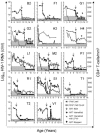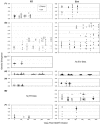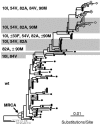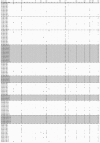Evidence that low-level viremias during effective highly active antiretroviral therapy result from two processes: expression of archival virus and replication of virus
- PMID: 16014925
- PMCID: PMC1181593
- DOI: 10.1128/JVI.79.15.9625-9634.2005
Evidence that low-level viremias during effective highly active antiretroviral therapy result from two processes: expression of archival virus and replication of virus
Abstract
Episodes of low-level viremia (LLV), with plasma human immunodeficiency virus type 1 (HIV-1) RNA levels ranging from 50 to 400 copies (c)/ml, occur commonly during highly active antiretroviral therapy (HAART). LLV has been associated with virologic failure of HAART in some studies, while in others LLV did not appear to affect the clinical outcome. To understand the processes leading to LLV, genetic analyses were used to determine whether plasma virions emanated from archived or from newly evolved viral genomes. Episodes of LLV (plasma HIV-1 RNA, 50 to 379 [median, 77] c/ml) were detected in 21/37 (57%) HIV-1-infected children with median plasma HIV-1 RNA levels of <50 c/ml during 79 patient years of HAART. Viral sequences were derived by direct sequencing of PCR products from 21 plasma specimens diluted to end point. In phylogenetic analysis, LLV viral sequences grouped with virus from early in the course of infection in 8/11 subjects. Six specimens had multiple identical viral sequences, suggesting origin from clonally expanded infected cells. LLV plasma virus evolved over time, indicating viral replication, in 3/11 subjects. Two of these had frequent LLV, including the selection of drug-resistant mutants. In summary, plasma virus from episodes of LLV during effective HAART appeared to originate from two distinct processes, (i) clonal outgrowth from long-lived HIV-1-infected cells, presumably following activation and proliferation of these cells, and (ii) ongoing viral replication that included the selection of new drug-resistant mutants. These observations provide a plausible explanation for the divergent clinical outcomes previously associated with LLV.
Figures





References
-
- Akaike, H. 1974. A new look at statistical model identification. IEEE Trans. Autom. Contr. 19:716-723.
-
- Aleman, S., K. Soderbarg, U. Visco-Comandini, G. Sitbon, and A. Sonnerborg. 2002. Drug resistance at low viraemia in HIV-1-infected patients with antiretroviral combination therapy. AIDS 16:1039-1044. - PubMed
-
- Altfeld, M., E. S. Rosenberg, R. Shankarappa, J. S. Mukherjee, F. M. Hecht, R. L. Eldridge, M. M. Addo, S. H. Poon, M. N. Phillips, G. K. Robbins, P. E. Sax, S. Boswell, J. O. Kahn, C. Brander, P. J. Goulder, J. A. Levy, J. I. Mullins, and B. D. Walker. 2001. Cellular immune responses and viral diversity in individuals treated during acute and early HIV-1 infection. J. Exp. Med. 193:169-180. - PMC - PubMed
-
- Bangsberg, D. R., E. D. Charlebois, R. M. Grant, M. Holoniy, S. G. Deeks, S. Perry, K. N. Conroy, R. Clark, D. Guzman, A. Zolopa, and A. Moss. 2003. High levels of adherence do not prevent accumulation of HIV drug resistance mutations. AIDS 17:1925-1932. - PubMed
-
- Chew, C. B., B. L. Herring, F. Zheng, C. Browne, N. K. Saksena, A. L. Cunningham, and D. E. Dwyer. 1999. Comparison of three commercial assays for the quantification of HIV-1 RNA in plasma from individuals infected with different HIV-1 subtypes. J. Clin. Virol. 14:87-94. - PubMed
Publication types
MeSH terms
Substances
Associated data
- Actions
- Actions
- Actions
- Actions
LinkOut - more resources
Full Text Sources
Other Literature Sources
Medical

